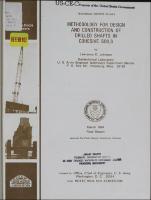Please use this identifier to cite or link to this item:
https://hdl.handle.net/11681/12815| Title: | Methodology for design and construction of drilled shafts in cohesive soils |
| Authors: | Johnson, Lawrence D. |
| Keywords: | Foundations Foundation design Foundation construction Soils Soil mechanics Caissons Strains Stresses Engineering design Methodology Structural engineering Shear strength of soils |
| Publisher: | Geotechnical Laboratory (U.S.) Engineer Research and Development Center (U.S.) |
| Series/Report no.: | Technical report (U.S. Army Engineer Waterways Experiment Station) ; GL-84-5. |
| Description: | Technical Report Abstract: Drilled shaft foundations are widely used in the construction of numerous types of permanent structures such as buildings, residences, bridges, and towers in unstable materials and fills including swelling soils. Much research has been done to develop des1gn procedures for drilled shaft foundations, but few comparisons had been made to validate the design methodologies for different soils and loading conditions. This report presents a comprehensive evaluation of different design procedures and describes those procedures that offer satisfactory solutions to the design of shaft foundations. Guidelines are provided for the design and construction of drilled shaft foundations subject to axial and lateral loading forces using either effective or total stress analysis. Axial load resistance is provided by skin and end bearing resistance. An appropriate maximum skin resistance may be calculated by using the cylindrical shear model with the soil strength reduced to compensate for remolding and softening of the soil. Maximum end bearing resistance may be calculated by Terzaghi's bearing capacity equation for general shear or by 9𝙲u where 𝙲u is the undrained shear strength. Long-term performance of two drilled shafts in swelling soil indicated that the skin resistance approached a maximum limited by the soil shear strength and that the end bearing capacity had been reduced and could be calculated by Terzaghi's bearing capacity equation for local shear or by 7𝙲u. Axial load-displacement behavior may be obtained by use of appropriate load transfer curves in a computer program such as AXILTR developed as part of this study. AXILTR is also capable of simulating uplift, downdrag, and pullout forces. Several load- transfer relationships were found satisfactory based on results of laboratory and field load tests if appropriate load-transfer curves are not known. A finite element program AXIPLN may also be applied to the estimation of vertical load-displacement behavior. Lateral load resistance is provided by the flexural rigidity of the shaft and the soil lateral resistance. Although elastic analysis is not applicable to flexible shafts over the full loading range, linear p-y curves can be useful within working range of the shaft less than one-half of the ultimate lateral capacity. Nonlinear load transfer p-y curves used in a computer program such as COM62 were found to offer satisfactory and safe estimates of lateral load-displacement behavior. The flexural stiffness of reinforced concrete shafts is less than the theoretical stiffness and may be approximated by Equat1on 10.7 of American Concrete Institute (ACI) Code 318-71 or Equations 10.9 and 10.10 of ACI Code 318-77. Criteria are described for evaluating appropriate load-transfer curves. An equation was developed for estimating the ultimate lateral load leading to structural failure in the shaft. Note: This file is very large. Allow your browser several minutes to download the file. |
| Rights: | Approved for public release; distribution is unlimited. |
| URI: | http://hdl.handle.net/11681/12815 |
| Appears in Collections: | Technical Report |
Files in This Item:
| File | Description | Size | Format | |
|---|---|---|---|---|
| TR-GL-84-5.pdf | 40.53 MB | Adobe PDF |  View/Open |